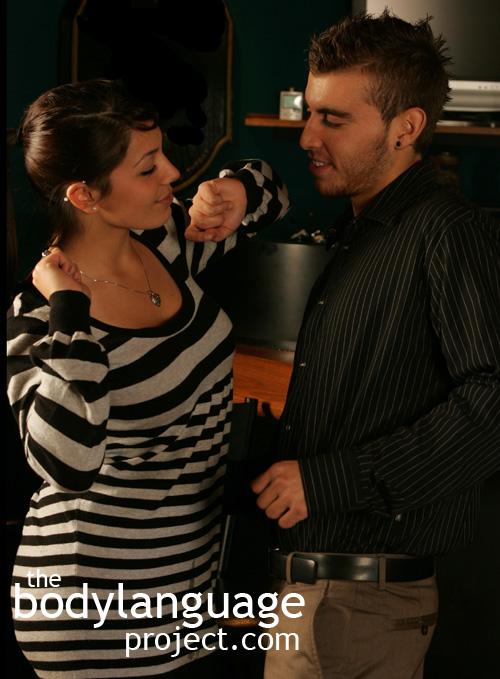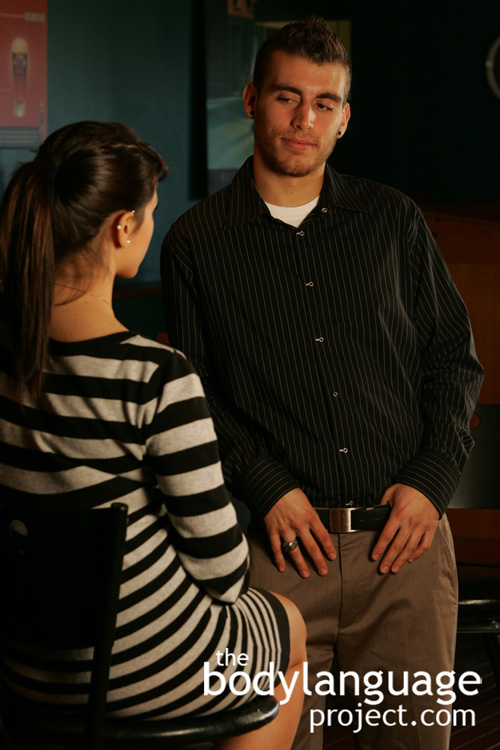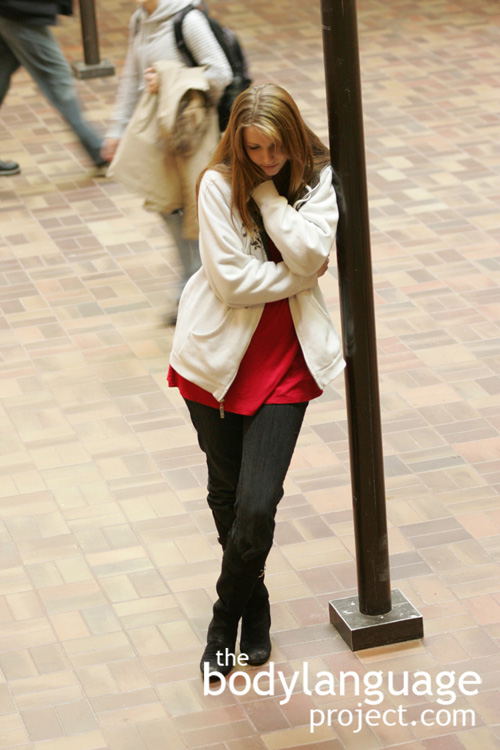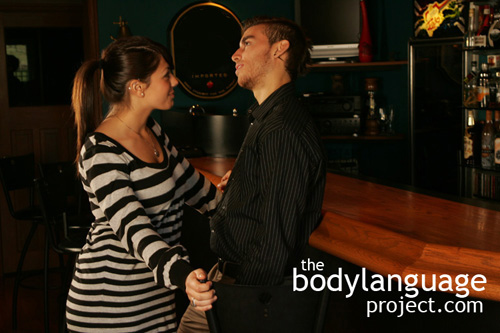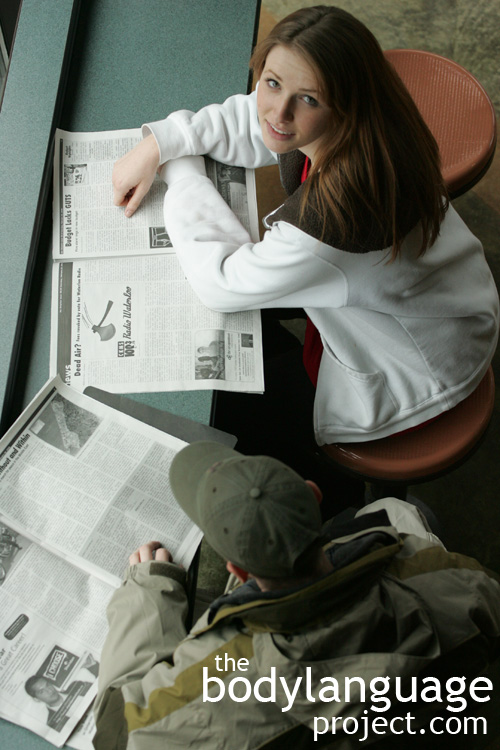Body Language of Dancing
Synonym(s): N/A
Description: A rhythmic movement of the body in concert with music.
In One Sentence: Dancing is a universal expression of happiness and joy, though it can also convey other emotions.
How To Use it: Use dancing to show others your good spirits and good health. Dancing does not have to be limited to the dance floor. Wiggling the hips to a tune while working, can show others that you are successful at life and are in command of your existence. Dancing is said to be the universal display of sexuality and virility. Men whom can dance, are seen as highly attractive as it cues athleticism and coordination which are two very desirable characteristics. Many of the movements in dance are much like movements during sex, so can elude to a man or woman’s sexy potency. Use dance to show off your personality.
Context: General
Verbal Translation: “I’m happy and having a good time so my body is moving to the beat.”
Variant: N/A.
Cue In Action: They picked up where they had left off, dancing to the beat.
Meaning and/or Motivation: A nonverbal expression of movement to music that is universally expressed. Dancing is a display of physical and sexual potential or an expression of art. Many different types of dancing exist throughout the world.
Cue Cluster: Dance is varied and the context will warrant various additional cues.
Body Language Category: Courtship displays, Emotional body language, Enthusiasm (nonverbal), Dominant body language.
Resources:
Atkinson AP, Dittrich WH, Gemmell AJ, Young AW (2004) Emotion perception from dynamic and static body expressions in point-light and full-light displays. Perception 33: 717–746. doi: 10.1068/p5096.
Bavelas, J. B., Black, A., Chovil, N., Lemery, C. R., & Mullett, J. (1988). Form and function in motor mimicry: Topographic evidence that the primary function is communicative. Human Communication Research, 14, 275- 299.
Bavelas, J. B., Black, A., Lemery, C. R., & Mullett, J. (1986). “I show how you feel”: Motor mimicry as a communicative act. Journal of Personality and Social Psychology, 50, 322-329.
Boone RT, Cunningham JG (1998) Children’s decoding of emotion in expressive body movement: the development of cue attunement. Dev Psychol. 34: 1007–1016. doi: 10.1037//0012-1649.34.5.1007.
Brownlow S, Dixon AR, Egbert CA, Radcliffe RD (1997) Perception of movement and dancer characteristics from point-light displays of dance. Psychol Rec 47: 411–421.
Camurri A, Lagerlo¨f I, Volpe G (2003) Recognizing emotion from dance movement: Comparison of spectator recognition and automated techniques. Int J Hum Comput Stud 59: 213–225. doi: 10.1016/S1071-5819(03)00050-8.
Davis, Martha. Movement characteristics of hospitalized psychiatric patients. American Journal of Dance Therapy. 1981. 4(1): 52-71.
de Meijer M (1989) The contribution of general features of body movement to the attribution of emotions. J Nonverbal Behav 13: 247–268. doi: 10.1007/BF00990296.
Dittrich WH, Troscianko T, Lea SEG, Morgan D (1996) Perception of emotion from dynamic point-light displays represented in dance. Perception 25: 727–738. doi: 10.1068/p250727.
Fink, Bernhard; Nadine Hugill and Benjamin P. Lange. Women’s Body Movements Are a Potential Cue to Ovulation. Personality and Individual Differences. 2012. 53: 759-763.
http://bodylanguageproject.com/articles/women-use-sexier-body-language-indicate-ovulation-fertility-women-dance-walk-sexier/
Geoffrey Miller, Joshua M. Tybur, Brent D. Jordan. Ovulatory Cycle Effects On Tip Earnings By Lap Dancers: Economic Evidence For Human Estrus? Evolution and Human Behavior, 2007; 28: 375–381.
http://bodylanguageproject.com/articles/lap-dancers-earn-more-during-peak-ovulation-how-the-pill-affects-your-sex-drive/
Godøy R (2010) Gestural affordances of musical sound. In: Godøy R, Leman M, editors. Musical gestures: Sound, movement, and meaning. New York, NY: Routledge. 103–125.
Grammer, Karl ; Kruck, Kirsten ; Magnusson, Magnus. The Courtship Dance: Patterns of Nonverbal Synchronization in Opposite-Sex Encounters. Journal of Nonverbal Behavior, 1998, Vol.22(1), pp.3-29.
Harrigan, Jinni ; Oxman, Thomas ; Rosenthal, Robert. Rapport expressed through nonverbal behavior. Journal of Nonverbal Behavior. 1985. 9(2): 95-110.
LaFrance, M. (1979). Nonverbal synchrony and rapport: Analysis by the cross-lag panel technique. Social Psychology Quarterly, 42, 66-70.
LaFrance, M. (1982). Posture mirroring and rapport. In M. Davis (Ed.), Interaction rhythms: Periodicity in communicative behavior (pp. 279-298).New York: Human Sciences Press.
LaFrance, M., & Broadbent, M. (1976). Group rapport: Posture sharing as a nonverbal indicator. Group and Organization Studies, 1, 328-333.
Lagerlo¨f I, Djerf M (2000) Communicating emotions: Expressiveness in modern dance. Int J Psychol 35: 225–225.
Manusov, Valerie. Mimicry or synchrony: The effects of intentionality attributions for nonverbal mirroring behavior. Communication Quarterly. 1992 40(1): 69-83.
Montepare, J. M., Goldstien, S. B., & Clausen, A. (1987). The identification of emotions from gait information. Journal of Nonverbal Behavior, 11, 33–42.
Moore, Monica. Courtship Signaling and Adolescents: Girls Just Wanna Have Fun. Journal of Sex Research. 1995. 32(4): 319-328.
http://bodylanguageproject.com/articles/girls-just-want-to-have-fun-the-origins-of-courtship-cues-in-girls-and-women/
Miller, G., Tybur, J. M., & Jordan, B. D. Ovulatory cycle effects on tip earning by lap dancers: Economic evidence for human estrus. Evolution and Human Behavior. 2007. 28: 375-381. http://dx.doi.org/10.1016/j.evolhumbehav.2007.06.002.
Neave, Nick; Kristofor McCarty; Jeanette Freynik; Nicholas Caplan; Johannes Hönekopp; Bernhard Fink. Male Dance Moves That Catch A Woman’s Eye. Biology Letters. 2011; 7(2): 221-224.
http://bodylanguageproject.com/articles/the-science-of-sexy-male-dance/
Nao, Misako Sawada and Motonobu Ishii. Development of the Movements Impressions Emotions Model: Evaluation of Movements and Impressions Related to the Perception of Emotions in Dance. Journal of Nonverbal Behavior. 2013. 37:107-121.
DOI 10.1007/s10919-013-0148-y
http://bodylanguageproject.com/articles/convey-emotion-nonverbally-dance-study/
Risner D (2009) What we know about boys who dance: The limitations of contemporary masculinity & dance education. In: Shay A, Fisher J, editors. When men dance: Choreographing masculinities across borders. New York, NY: Oxford University Press.
Ricard, Nathalie C. ; Beaudry, Simon G. ; Pelletier, Luc G. Lovers With Happy Feet: The Interdependence of Relationship and Activity Factors for Individuals Dancing With a Romantic Partner.(Report). Journal of Applied Social Psychology. 2012. 42(4): 939(25).
Sawada, M., Suda, K., & Ishii, M. (2003a). Expression of emotions in dance: Relation between arm movement characteristics and emotion. Perceptual and Motor Skills, 97, 697–708.
Sawada, M., Suda, K., & Ishii, M. (2003b). Relationship between leg movement quality and emotional expression in dance. Poster session presented at the annual meeting of the International Association for Dance Medicine & Science, London, England.
Van Meel J, Verburgh H, de Meijer M (1993) Children’s interpretation of dance expressions. Empirical Studies of the Arts 11: 117–133. doi: 10.2190/V69NVB0T-A9Q3-TJ04.
Van Dyck, Edith ; Vansteenkiste, Pieter ; Lenoir, Matthieu ; Lesaffre, Micheline ; Leman, Marc Canal-bruland, Rouwen. Recognizing Induced Emotions of Happiness and Sadness from Dance Movement. PLoS ONE. 2014 9(2): e89773.
Van Dyck E, Maes P-J, Hargreaves J, Lesaffre M, Leman M (2013). Expressing induced emotions through free dance movement. J Nonverbal Behav 37: 175–190. doi: 10.1007/s10919-013-0153-1.
Whittock, Trevor. The role of metaphor in dance. The British Journal of Aesthetics. 1992. 32(3): 242(8).

